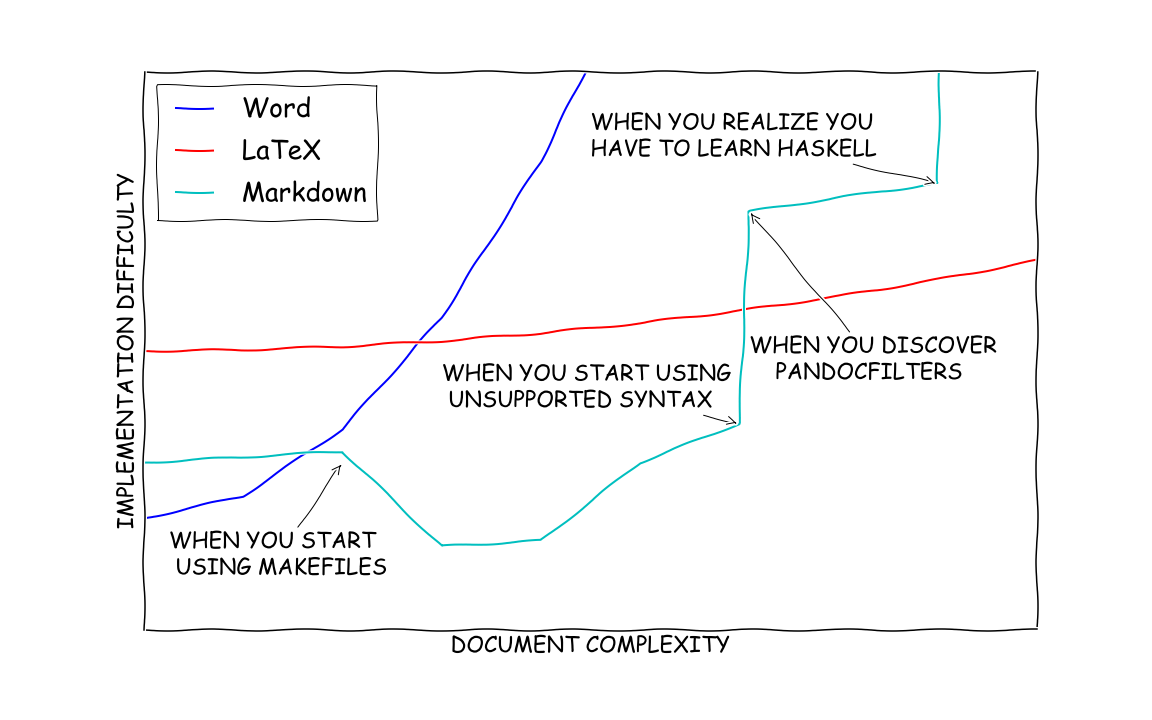import matplotlib
import matplotlib.pyplot as plt
import numpy as np
ALPHA = 0.25
with plt.xkcd():
plt.rcParams.update({'font.size': 22})
x = np.arange(0, 1, 0.1)
word_y = 40 * x**2 + 2
latex_y = 2 * x**2 + 5
markdown_y = np.array([3, 3.1, 3.2, 1.5, 1.6, 3, 3.7, 7.5, 7.75, 8, 100])
markdown_x = np.array([0.0, 0.1, 0.2, 0.3, 0.4, 0.5, 0.6, 0.61, 0.7, 0.8, 0.9])
quarto_y = 22.5 * (x-0.3)**2 + 0.75
fig, axs = plt.subplots(1, 1, figsize=(16, 10))
ax = axs
segment_positions = [0.25, 0.5, 0.75]
segment_labels = ['Basic Reports OR\nStandard Documents', 'Papers with Figures\nbased on Results', 'Per-Page Layout\nOR Web Content', 'Professional\nBook Layout']
range_starts = [0, 0.25, 0.5, 0.75]
range_ends = [0.25, 0.5, 0.75, 0.9]
y_pos_annotations = -0.15
y_pos_arrows = -0.1
for start, end, label in zip(range_starts, range_ends, segment_labels):
ax.annotate('',
xy=(start, y_pos_arrows), xycoords=('data', 'axes fraction'),
xytext=(end, y_pos_arrows), textcoords=('data', 'axes fraction'),
arrowprops=dict(arrowstyle='<->', color='black'))
for i, position in enumerate(segment_positions):
ax.axvline(x=position, color='black', linestyle='-.', linewidth=0.5, alpha = 0.5)
ax.annotate(segment_labels[i],
xy=(position, 0), xycoords=('data', 'axes fraction'),
xytext=(-125, -50), textcoords='offset points',
ha='center', va='baseline', alpha = 0.5)
ax.annotate(segment_labels[-1],
xy=(1, 0), xycoords=('axes fraction', 'axes fraction'),
xytext=(-75, -50), textcoords='offset points',
ha='center', va='baseline', alpha = 0.5)
word_line, = ax.plot(x, word_y, label="Word")
latex_line, = ax.plot(x, latex_y, label="LaTeX")
markdown_line, = ax.plot(markdown_x, markdown_y, alpha=ALPHA, label="Markdown")
quarto_line, = ax.plot(x, quarto_y, linewidth=5, label="Quarto")
ax.legend(handles=[word_line, latex_line, markdown_line, quarto_line], loc="upper left")
ax.set_ylim(0, 10)
ax.set_xlim(0, 0.9)
arrowprops = dict(arrowstyle="->", alpha=ALPHA)
ax.annotate("WHEN YOU START\n USING MAKEFILES", xy=(0.2, 3.3), arrowprops=arrowprops, xytext=(0.025, 3.75), alpha = ALPHA/5)
ax.annotate("WHEN YOU START USING\n UNSUPPORTED SYNTAX", xy=(0.6, 3.7), arrowprops=arrowprops, xytext=(0.30, 4), alpha = ALPHA/5)
ax.annotate("WHEN YOU DISCOVER\n PANDOCFILTERS", xy=(0.61, 7.5), arrowprops=arrowprops, xytext=(0.375, 6.25), alpha = ALPHA/5)
ax.annotate("WHEN YOU REALIZE YOU \nHAVE TO LEARN HASKELL", xy=(0.8, 8), arrowprops=arrowprops, xytext=(0.45, 8.5), alpha=ALPHA/5)
ax.get_xaxis().set_ticks([])
ax.get_yaxis().set_ticks([])
ax.set_xlabel("DOCUMENT COMPLEXITY")
ax.xaxis.set_label_position('top')
ax.set_ylabel("IMPLEMENTATION DIFFICULTY")

